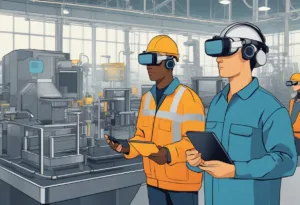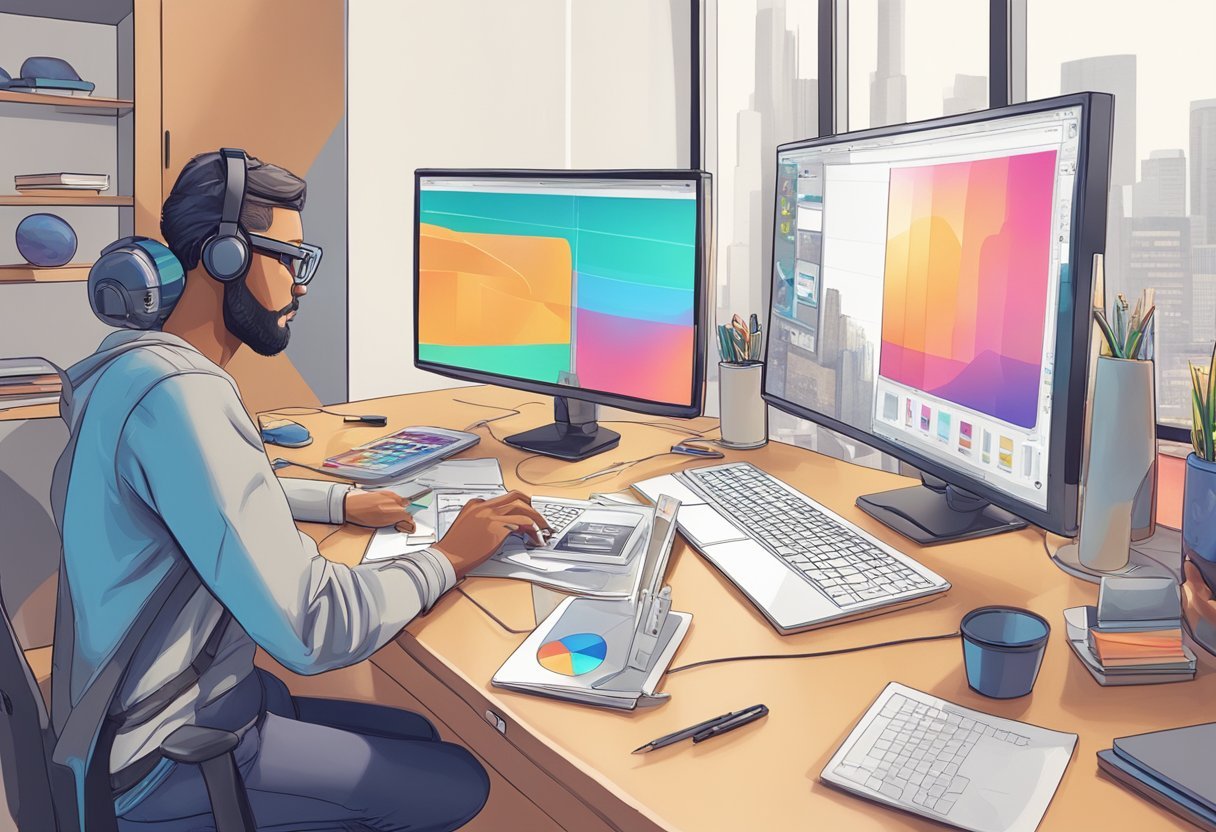Augmented reality (AR) is a technology that has been gaining popularity in recent years. It is a type of technology that allows users to experience a computer-generated environment that is overlaid onto the real world. AR has a wide range of applications, from entertainment to education, and has the potential to change the way we interact with technology in the future. In this blog post, I will share with 15 cool augmented reality ideas to help enhance your business profile in AR
One of the most exciting things about AR is its potential to revolutionize the way we learn and teach. AR can be used to create immersive educational experiences that allow students to interact with digital content in a way that was previously impossible. For example, an AR app could be used to create a virtual tour of a historical site, allowing students to explore the site in a way that is both engaging and informative.
Fundamentals of Augmented Reality
Augmented Reality (AR) is a technology that superimposes computer-generated images on a user’s view of the real world, thereby enhancing the user’s perception of reality. AR technology uses various hardware and software components to create these virtual images. The technology has been around for several years, but it has only recently gained widespread adoption with the growth of mobile devices and advancements in hardware and software.
AR technology uses various sensors like cameras, LiDAR, and GPS to track the user’s position and orientation, and then overlays digital content onto the real world. AR technology can be used in various fields, including gaming, education, healthcare, and marketing.
AR Devices and Hardware
AR devices and hardware play a critical role in the AR experience. The hardware used in AR devices includes cameras, sensors, processors, and displays. AR devices can be categorized into three types: handheld devices, head-mounted displays, and smart glasses.
Handheld devices are the most common AR devices and include smartphones and tablets. These devices use the device’s camera and sensors to track the user’s position and orientation and overlay digital content onto the real world.
Head-mounted displays (HMDs) are another type of AR device that is worn on the head. HMDs use sensors and cameras to track the user’s position and orientation, and then overlay digital content onto the real world. HMDs can be further divided into two categories: tethered and untethered.
Smart glasses are a new type of AR device that looks like regular glasses but has a built-in display. Smart glasses use sensors and cameras to track the user’s position and orientation and overlay digital content onto the real world.
Software Behind AR Experiences
The software behind AR experiences plays a critical role in creating a seamless and immersive AR experience. AR software includes AR frameworks like ARCore and ARKit, which provide developers with the tools to create AR apps and experiences.
ARCore is an AR framework developed by Google that allows developers to create AR experiences for Android devices. ARCore uses the device’s camera and sensors to track the user’s position and orientation and overlay digital content onto the real world.
ARKit is an AR framework developed by Apple that allows developers to create AR experiences for iOS devices. ARKit uses the device’s camera and sensors to track the user’s position and orientation and overlay digital content onto the real world.
Graphics software like Unity and Unreal Engine are also used to create AR experiences. These software tools provide developers with the tools to create 3D models, animations, and other digital content that can be overlaid onto the real world.
AR technology has come a long way in recent years, and with the advancements in hardware and software, it has become more accessible to developers and consumers alike. With the right hardware and software, AR experiences can be created that are immersive, engaging, and provide users with a new way to interact with the world around them.
15 Cool Augmented Reality Ideas

- Virtual Try-Ons: Allow customers to try on clothes, glasses, or makeup virtually.
- Interactive Education: Bring textbooks and educational materials to life with 3D models and interactive elements.
- AR Gaming: Overlay digital game elements onto the real world, like in Pokémon Go.
- Navigation Assistance: Provide real-time AR navigation cues in physical spaces.
- Historical Reconstructions: Visualize historical sites or events overlaid on present-day locations.
- Interactive Marketing: Create engaging AR campaigns that allow customers to interact with products.
- Maintenance and Repair: Overlay machinery with step-by-step instructions for maintenance or repair tasks.
- Real Estate Visualization: Show potential buyers what an unfurnished property could look like when furnished.
- Fitness Programs: Offer guided workouts with AR personal trainers.
- Live Events Enhancement: Enhance concerts or sports events with AR effects and information.
- Art Installations: Create immersive art experiences that blend physical and digital elements.
- Medical Procedures: Assist in medical training or actual procedures with AR visualizations.
- Retail Shopping: Visualize how products would look in a space before purchasing.
- Cultural Experiences: Enhance museum visits with AR displays that provide additional information about exhibits.
- Product Previews: Enable customers to see how a product works or looks from all angles before buying.
Augmented Reality in Various Industries

Augmented Reality (AR) is a technology that is transforming various industries by enhancing user experiences. This technology allows users to interact with the real world in a more immersive and engaging way. AR is becoming increasingly popular in various industries, including retail, education, entertainment, and art.
AR in Retail and Business
AR is transforming the retail industry by providing customers with a more interactive and personalized shopping experience. Brands like IKEA are using AR to help customers visualize how furniture would look in their homes. Customers can use their smartphone cameras to scan a room and place virtual furniture in it to see how it would look. This helps customers make more informed decisions and reduces the chances of them returning the product.
AR is also being used in the business industry to improve productivity and efficiency. Workers can use AR to visualize and use data in real-time, enabling them to make timely data-driven decisions. It also promotes virtues like cross-team collaboration, paperless workforce, and simplified workflows.
Educational Applications of AR
AR is transforming the way students learn by providing them with a more interactive and engaging learning experience. AR can be used to create 3D models of complex concepts, making it easier for students to understand. It can also be used to create virtual field trips, allowing students to explore places they might not otherwise be able to visit.
One example of AR in education is the augmented reality sandbox developed by UC Davis. This sandbox uses projection-based AR to create a more hands-on learning environment. This innovation uses a Microsoft Kinect 3D camera, visualization software, and a projector.
AR in Entertainment and Gaming
AR is transforming the entertainment industry by providing users with a more immersive and engaging experience. One notable example is the popular game, Pokémon Go. The game uses AR to allow players to catch virtual Pokémon in the real world. This game became a global phenomenon and demonstrated the potential of AR in the gaming industry.
The Role of AR in Art and Museums
AR is transforming the art and museum industry by providing visitors with a more interactive and engaging experience. AR can be used to bring exhibits to life by providing additional information about the artwork. It can also be used to create virtual exhibits, allowing visitors to explore exhibits that might not otherwise be accessible.
AR is transforming various industries by providing users with a more interactive and engaging experience. It is becoming increasingly popular in industries such as retail, education, entertainment, and art. AR is a technology that is here to stay and will continue to transform the way we interact with the world around us.
Augmented Reality for Marketing and Advertising

Augmented Reality (AR) has become an increasingly popular tool for businesses to enhance their marketing and advertising campaigns. By providing an interactive and engaging experience for customers, AR has the potential to increase brand engagement and ultimately drive revenue.
Innovative AR Marketing Campaigns
Several companies have successfully implemented innovative AR marketing campaigns. For example, Pepsi Max launched an AR campaign that allowed customers to play a virtual soccer game by scanning a QR code on their can. The campaign generated over 3 million interactions and increased Pepsi Max’s sales by 30%.
Netflix also used AR to promote their hit show, Stranger Things. They created an AR app that allowed users to explore the show’s fictional town of Hawkins, Indiana. The app generated buzz and excitement for the show’s upcoming season.
Enhancing Brand Engagement with AR
AR can also be used to enhance brand engagement. For example, businesses can use AR to create interactive business cards that allow customers to scan the card and view a 3D model of the product or service being offered. This provides a unique and memorable experience for customers, increasing the likelihood that they will remember the brand.
In addition, AR can be used to create immersive experiences for customers. Brands can use AR to create virtual showrooms or product demonstrations, allowing customers to interact with products in a way that was previously impossible. This can increase customer engagement and ultimately drive sales.
AR has the potential to revolutionize the way businesses approach marketing and advertising. By providing interactive and engaging experiences for customers, businesses can increase brand engagement and drive revenue.
Technical Aspects and Development of AR

Building AR Applications
Augmented Reality (AR) is a technology that enhances the real world by superimposing computer-generated information on top of it. Building AR applications requires a deep understanding of the technical aspects involved in the development process.
AR experiences can be built using a variety of software tools and platforms. Augmented Reality software such as Unity, Vuforia, and ARKit can be used to create AR experiences for mobile devices and tablets. These software tools provide developers with the necessary tools to create AR experiences that are interactive and engaging for users.
AR developers also need to have knowledge of AI and RAM (Random Access Memory) to develop AR applications that are efficient and responsive. AI can be used to optimize the performance of AR applications and make them more intelligent. RAM is essential for the smooth functioning of AR applications, and developers need to ensure that the applications are optimized to use the available RAM efficiently.
Challenges in AR Development
AR development poses several challenges that developers need to overcome to create high-quality AR experiences. One of the major challenges is troubleshooting. AR applications need to be tested thoroughly to ensure that they work seamlessly on different mobile devices and tablets. Troubleshooting can be time-consuming and requires a lot of effort from developers.
Another challenge in AR development is the need to create AR experiences that are intuitive and easy to use. AR applications need to be designed in a way that users can easily interact with them and understand their purpose. Developers need to focus on creating AR experiences that are user-friendly and provide a seamless experience.
Building AR applications requires a deep understanding of the technical aspects involved in the development process. AR developers need to have knowledge of AI, RAM, and troubleshooting to create high-quality AR experiences. They also need to focus on creating AR experiences that are intuitive and easy to use for users.
Future Trends and Innovations in AR
The Intersection of AR and AI
The future of augmented reality (AR) is closely tied to the development of artificial intelligence (AI). The use of AI in AR can help to improve the accuracy and efficiency of tasks such as face and room scanning. This can lead to more immersive and engaging AR experiences for users. As AI continues to evolve, we can expect to see even more advanced AR applications in the future.
AR’s Role in the Metaverse
AR is set to play a significant role in the development of the metaverse, a virtual world that is currently being built by a number of companies. AR can help to create more immersive and interactive experiences within the metaverse, allowing users to interact with virtual objects as if they were real. As the metaverse continues to grow, we can expect to see even more innovative AR applications being developed.
Investments and the Future of AR
Investments in AR technology are expected to continue to grow in the coming years. This is due to the increasing demand for AR applications in a variety of industries, including gaming, education, and healthcare. As more companies invest in AR technology, we can expect to see even more innovative applications being developed. The use of blockchain technology in AR can help to improve security and transparency, making AR applications more reliable and trustworthy.
The future of AR looks promising, with advancements in AI, the development of the metaverse, and continued investments in AR technology. As the technology continues to evolve, we can expect to see even more innovative and engaging AR applications being developed.
Frequently Asked Questions

What industries are currently adopting augmented reality technology?
Augmented reality technology is being adopted across various industries, including education, healthcare, entertainment, retail, and manufacturing. In education, AR is being used to create interactive learning experiences that enhance student engagement and retention. In healthcare, AR is being used for medical training and to improve patient outcomes. In retail, AR is being used to create immersive shopping experiences that allow customers to visualize products in their homes before making a purchase. In manufacturing, AR is being used to improve worker safety and efficiency.
Can you provide some successful case studies of augmented reality applications?
There are many successful case studies of augmented reality applications. For example, the furniture retailer IKEA uses an AR app that allows customers to visualize furniture in their homes before making a purchase. The National Museum of Singapore uses AR to create interactive exhibits that enhance the visitor experience. The car manufacturer Audi uses AR to train technicians and improve the efficiency of their service centers.
How can students incorporate augmented reality into their learning experiences?
Students can incorporate augmented reality into their learning experiences by using AR apps and platforms to create interactive projects and presentations. For example, students can use AR to create 3D models of historical or scientific concepts that can be viewed from different angles. They can also use AR to create interactive quizzes and games that test their knowledge and understanding of a topic.
What are some beginner-level project ideas for exploring augmented reality?
Some beginner-level project ideas for exploring augmented reality include creating an AR app that displays information about a local landmark or historical site, creating an AR game that teaches a specific concept or skill, or creating an AR art project that allows viewers to interact with the artwork in a new way.
Where can I find source code for augmented reality projects to learn from?
There are many resources available for finding source code for augmented reality projects. Some popular platforms for finding AR source code include GitHub, Unity Asset Store, and Vuforia Developer Portal. Many AR development courses and tutorials provide sample code that can be used as a starting point for creating AR projects.
What are the key characteristics that define a high-quality augmented reality experience?
A high-quality augmented reality experience should be immersive, interactive, and intuitive. It should provide users with a seamless integration of digital and physical elements, and it should be easy to navigate and understand. A high-quality AR experience should be optimized for the device it is being used on, providing users with a smooth and responsive experience.




